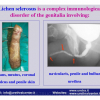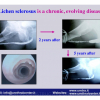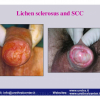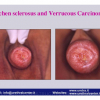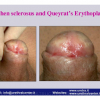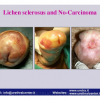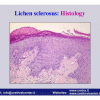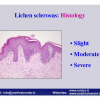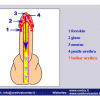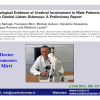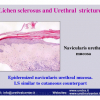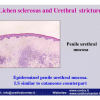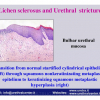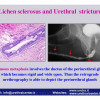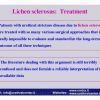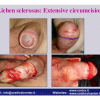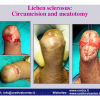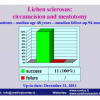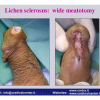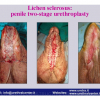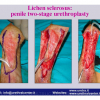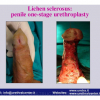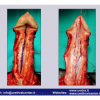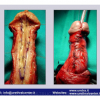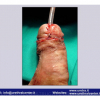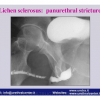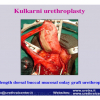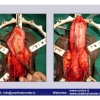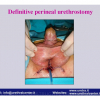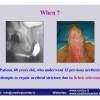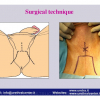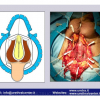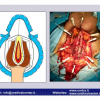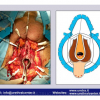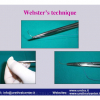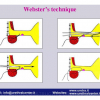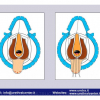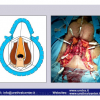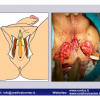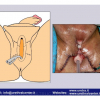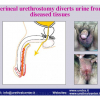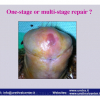Il lichen sclerosus causa cicatrici ostruenti che possono creare problemi alla sfera urinaria e sessuale e minare la qualità della vita dei pazienti. I sintomi più frequenti sono il prurito, dolore, difficoltà alla retrazione della cute del prepuzio e getto urinario debole. L’esame clinico rivela le tipiche placche biancastre a macchia di leopardo che coinvolgono il glande, la cute del prepuzio che appare fimotica e la stenosi del meato.
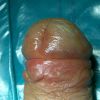 |
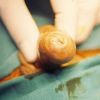 |
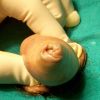 |
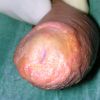 |
Lettura n° 1:
| Reconstruction of urethral strictures due to lichen sclerosus 28th Congress of the Société Internationale d’Urologie November 12 – 16, 2006 Cape Town – South Africa |
 scarica PDF |
|
|
|
||
| Lettura n° 2: | ||
| BXO – Lichen sclerosus III° Simposio Internacional de Cirurgia Urologica Reconstrutora April 11-12, 2008 Rio de Janeiro-Brazil |
 scarica PDF |
|
|
|
||
| Lettura n° 3: | ||
| Lichen sclerosus genito-urinario Società Italiana Urologia Territoriale (SIUT) Urologi Ospedalità Privata (Ur.O.P.) September 22 – 28, 2008 Rome – Italy |
 scarica PDF |
|
|
|
||
| Lettura n° 4: | ||
| Lichen sclerosus Overview: etiology, clinical presentation and management Muljibhai Patel Urological Hospital “URETHROPLASTY” July 19 – 20, 2012 Nadiad – Gujarat – India |
 scarica PDF |
Articolo n° 1
Lichen sclerosis of male genitalia involving anterior urethra
Lancet 1999; 354(number 9176): 429.
Articolo n° 2
Lichen sclerosus involving anterior urethra
J. Urol 1999; 16 1: 102 (Abstract 384).
Articolo n° 3
Lichen Sclerosus of the male genitalia
Contemporary Urology 2001; 13:, 47-58.
Articolo n° 4
Lichen sclerosus of the male genitalia and urethral stricture diseases
Urol Int 2004; 73: 1-5.
Articolo n° 5
Penile carcinoma in patients with genital lichen sclerosus: a multicenter survey
J Urol 2006; 175: 1359-1363.
Articolo n° 6
Resurfacing and reconstruction of the glans penis
Eur Urol 2007; 52: 893-900.
Articolo n° 7
Lichen Sclerosus of the Male Genitalia and Urethra: Surgical Options and Results in a Multicenter International Experience with 215 Patients
Eur Urol 2009; 55: 945-956.
Lichen sclerosis of male genitalia involving anterior urethra
Lancet 1999; 354(number 9176): 429.
Articolo n° 2
Lichen sclerosus involving anterior urethra
J. Urol 1999; 16 1: 102 (Abstract 384).
Articolo n° 3
Lichen Sclerosus of the male genitalia
Contemporary Urology 2001; 13:, 47-58.
Articolo n° 4
Lichen sclerosus of the male genitalia and urethral stricture diseases
Urol Int 2004; 73: 1-5.
Articolo n° 5
Penile carcinoma in patients with genital lichen sclerosus: a multicenter survey
J Urol 2006; 175: 1359-1363.
Articolo n° 6
Resurfacing and reconstruction of the glans penis
Eur Urol 2007; 52: 893-900.
Articolo n° 7
Lichen Sclerosus of the Male Genitalia and Urethra: Surgical Options and Results in a Multicenter International Experience with 215 Patients
Eur Urol 2009; 55: 945-956.
1. Domanda: Per questo tipo di intervento quale tipo di anestesia è previsto?
Risposta: Anestesia generale senza intubazione oro-tracheale.
2. Domanda: Quante ore dura l’intervento?
Risposta: Circa 1 ora.
3. Domanda: Ci sono rischi per l’erezione, dopo l’intervento?
Risposta: No
4. Domanda: Quanti sono i giorni di degenza in ospedale previsti per questo intervento?
Risposta: In genere il ricovero ospedaliero varia da 2 a 3 giorni.
5. Domanda: Per quanto tempo dovrò portare il catetere dopo l’intervento? È doloroso portare il catetere?
Risposta: Il catetere deve rimanere in sede per 24 ore dopo l’intervento. Il catetere è ben tollerato e non crea particolari problemi in quanto è di piccolo calibro e di puro silicone.
6. Domanda: Quali particolari limitazioni sono suggerite durante la convalescenza?
Risposta: Durante la convalescenza è suggerito l’uso di un antibiotico per via orale per 5 giorni. È suggerito di non effettuare attività sessuale.
7. Domanda: Quanto tempo dopo l’intervento potrò riprendere la mia attività lavorativa, sportiva e sessuale?
Risposta: Le attività lavorativa e sportiva possono essere riprese dopo la dimissione dall’ospedale. L’attività sessuale dopo 15 giorni dall’intervento.
8. Domanda: Dopo l’intervento posso usare la bicicletta od il motorino?
Risposta: Si.
9. Domanda: Quali cibi e bevande devo evitare dopo l’intervento?
Risposta: Nessuno.
Risposta: Anestesia generale senza intubazione oro-tracheale.
2. Domanda: Quante ore dura l’intervento?
Risposta: Circa 1 ora.
3. Domanda: Ci sono rischi per l’erezione, dopo l’intervento?
Risposta: No
4. Domanda: Quanti sono i giorni di degenza in ospedale previsti per questo intervento?
Risposta: In genere il ricovero ospedaliero varia da 2 a 3 giorni.
5. Domanda: Per quanto tempo dovrò portare il catetere dopo l’intervento? È doloroso portare il catetere?
Risposta: Il catetere deve rimanere in sede per 24 ore dopo l’intervento. Il catetere è ben tollerato e non crea particolari problemi in quanto è di piccolo calibro e di puro silicone.
6. Domanda: Quali particolari limitazioni sono suggerite durante la convalescenza?
Risposta: Durante la convalescenza è suggerito l’uso di un antibiotico per via orale per 5 giorni. È suggerito di non effettuare attività sessuale.
7. Domanda: Quanto tempo dopo l’intervento potrò riprendere la mia attività lavorativa, sportiva e sessuale?
Risposta: Le attività lavorativa e sportiva possono essere riprese dopo la dimissione dall’ospedale. L’attività sessuale dopo 15 giorni dall’intervento.
8. Domanda: Dopo l’intervento posso usare la bicicletta od il motorino?
Risposta: Si.
9. Domanda: Quali cibi e bevande devo evitare dopo l’intervento?
Risposta: Nessuno.
| Risultati aggiornati al 31 dicembre 2021 | |||

Tabella pazienti |
|||











